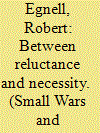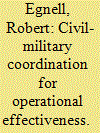| Srl | Item |
| 1 |
ID:
083038


|
|
|
|
|
| Publication |
2008.
|
| Summary/Abstract |
The civil-military interface in peace support operations is changing due to increasingly overlapping tasks, increased military involvement in humanitarian activities, and increased integration of all involved actors, not least through various current strategic concepts. This article not only describes these trends, but also, more importantly, analyses certain consequences in terms of mission effectiveness. The focus of the analysis is the ideas of 'militarisation of humanitarian aid' and the reverse 'humanitarianisation of the military'. The main arguments of this contribution are that the assumptions of increased effectiveness stemming from civil-military integration cannot be taken for granted and that there are harmful consequences stemming from blurring the lines between civilian, humanitarian and military actors. There is, in other words, a need to better specify and explain the causal mechanisms that lead to effectiveness in complex peace support operations.
|
|
|
|
|
|
|
|
|
|
|
|
|
|
|
|
| 2 |
ID:
120307


|
|
|
|
|
| Publication |
2013.
|
| Summary/Abstract |
The last decade has witnessed a cascading proliferation of strategic concepts that emphasise the importance of civil-military cooperation, coordination, or integration for effectiveness in complex operations. These efforts nevertheless often lack an appreciation for why, where, and how such integration and coordination should take place to achieve the desired outcomes. This article introduces a new approach to civil-military coordination that incorporates the challenges and possibilities at both the national/strategic level and the tactical level in field of operations. By integrating and coordinating these efforts at the strategic level, this approach allows policymakers to achieve separation of actors and responsibilities in the field of operations. By doing so, the proposed approach seeks to answer more specific questions about when coordination is necessary for effectiveness, what its aims are, what actors need to be involved, and to what extent and at what level of command the actors need to be coordinated.
|
|
|
|
|
|
|
|
|
|
|
|
|
|
|
|